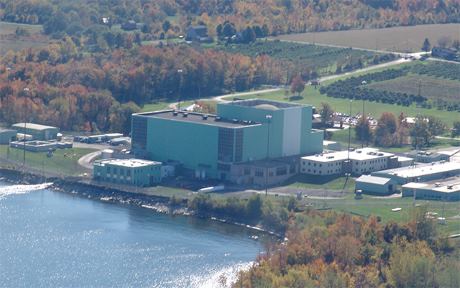The State of New York Public Service Commission yesterday ruled that non-carbon-emitting generation resources including nuclear power plants must be included in the state's Clean Energy Standard (CES) portfolio. The CES is to include a support mechanism for upstate nuclear power plants at risk of closure for economic reasons.
 |
| Ginna: One of New York's "upstate" plants (Image: Exelon) |
State governor Andrew Cuomo in December directed the public service commission to develop the CES to ensure that the state achieves its goal of 50% renewable energy by 2030. The public service commission has now formally stated that it will expand the scope of the CES to include the contributions of the nuclear plants. The commission's decision was announced by Cuomo's office alongside the approval of a 10-year, $5 billion Clean Energy Fund to accelerate the growth of the state's clean energy economy.
In December, the governor mandated the commission to evaluate ways in which zero emission resources may be retained as a short-term "bridge" while the state is undergoing its transition. He specifically directed it to include a process to prevent the premature retirement of "upstate" nuclear power plants, stating that the "elimination" of such facilities would "eviscerate the emission reductions achieved" through renewable energy programs, while diminishing fuel diversity, increasing price volatility and financially harming host communities.
New York State is home to a total of six nuclear reactors operating at four sites. These include the so-called upstate plants - two units at Nine Mile Point and single units at RE Ginna and James A Fitzpatrick - and the two Indian Point reactors, which are located in the south-east of the state, 24 miles (39 kilometres) from New York City. The Indian Point reactors, currently the subject of a licence application renewal which has been challenged by the New York State Department of State, would therefore not appear to be included in the CES.
US nuclear plants operating in deregulated markets, like those in New York State, have found themselves facing economic challenges from the short-term nature of the competitive market, coupled with competition from low-cost gas and federally subsidized wind power. Entergy announced in November 2015 that it intends to close the Fitzpatrick plant in late 2016 or early 2017 for economic reasons.
Exelon, operator of Ginna and Nine Mile Point, commended the New York Public Service Commission decision. Exelon's executive vice president of governmental and regulatory affairs and public policy Joe Dominguez said: "Progressive energy policies will help ensure that Exelon's upstate nuclear stations can continue delivering zero-carbon electricity and driving local economies for many years to come. We look forward to working with the governor, the PSC and other stakeholders to learn more about this ambitious plan."
The public service commission will now work on drawing up the CES which it expects to have ready for "consideration" by June.
Researched and written
by World Nuclear News




_18570.jpg)
_16159.jpg)
_18938.jpg)
_33584.jpg)





